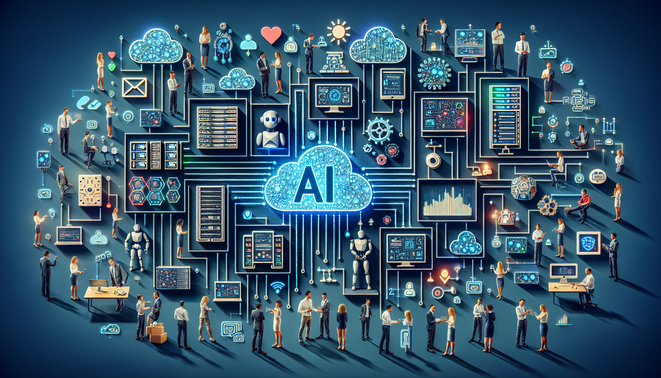Physical Address
304 North Cardinal St.
Dorchester Center, MA 02124
Physical Address
304 North Cardinal St.
Dorchester Center, MA 02124

AI in Cloud SaaS Platforms: Transforming Customer Engagement
Meta Summary: Explore how AI integration in Cloud SaaS platforms revolutionizes customer engagement through personalized marketing, automated support, and real-time analytics. Learn about architectural frameworks, best practices, and real-world case studies for optimizing AI strategies in SaaS environments.
Introduction to AI in Cloud SaaS Platforms
Artificial Intelligence (AI) is revolutionizing customer engagement in Cloud Software as a Service (SaaS) platforms. AI simulates human intelligence with transformative capabilities that enhance the emotional connection between customers and brands.
Learning Objectives:
Understand the role of AI in transforming customer engagement.
Identify key trends in AI adoption in Cloud SaaS.
AI in SaaS enables businesses to harness data-driven insights, automate repetitive tasks, and deliver personalized experiences. These advancements not only improve customer satisfaction but also drive business growth and efficiency. Key trends include AI for personalized marketing, automated customer support, and real-time analytics.
Architectural Framework for AI Customer Engagement
Building AI systems for customer engagement in SaaS involves a comprehensive architectural framework, including data collection, processing, model training, and deployment. This entails robust infrastructure, scalable computing resources, and seamless integration with SaaS applications.
Learning Objectives:
Describe the architecture of large-scale AI systems in SaaS.
Examine tools and platforms used for AI development.
The architecture typically consists of data lakes for storage, machine learning platforms for model training, and APIs for integration. DevOps tools like Kubernetes and Docker facilitate AI models’ continuous deployment and scaling.
Tip: Integrate AI seamlessly with existing SaaS applications and optimize based on user feedback.
Pitfalls:
Underestimating data integration complexity.
Inadequate training for staff on AI tools.
Personalized Marketing Strategies Using AI
AI-driven personalized marketing enables tailoring communication to customer preferences, enhancing engagement and conversions. AI analyzes data to segment audiences and delivers targeted campaigns.
Learning Objectives:
Assess how AI can personalize marketing efforts.
Explore techniques for segmenting customer data.
By analyzing behavior and preferences, AI sends personalized emails, recommends products, and optimizes spend. A case study showed a retail company increasing sales by 25% through tailored email campaigns.
Best Practices:
Ensure compliance with data privacy regulations.
Pitfalls:
Misaligning AI initiatives with business goals.
Support Automation and its Impact on Customer Experience
Automated support systems powered by AI enhance customer experience by offering quick, efficient, and consistent service. AI chatbots and virtual assistants manage routine inquiries, allowing human agents to focus on complex issues.
Learning Objectives:
Analyze the benefits of automated support systems.
Evaluate AI tools for customer support automation.
An example is a telecom provider reducing support ticket resolution by 40% with AI chatbots. These systems improve satisfaction and reduce costs.
Best Practices:
Continuously monitor and optimize models with feedback.
Pitfalls:
Inadequate training for staff on AI tools.
Real-Time Analytics for Enhanced Engagement
AI-powered real-time analytics allows businesses to make decisions quickly, enhancing engagement. Systems analyze live data, offering actionable insights.
Learning Objectives:
Learn about frameworks for real-time decision-making.
Explore case studies on analytics-enhanced engagement.
AI dashboards offer a complete view of interactions, aiding trend response, campaign optimization, and service delivery improvement.
Best Practices:
Use analytics to fine-tune customer service strategies.
Evaluating ROI from AI Implementations
Measuring AI initiatives’ ROI is crucial for investment justification and strategic guidance. This includes comparing AI benefits to costs.
Learning Objectives:
Develop strategies to measure AI initiatives’ ROI.
Identify cost implications and savings from AI.
Businesses should establish KPIs and conduct cost-benefit analyses to comprehend financial impact and guide strategies.
Note: Align AI projects with clear business objectives for optimal results.
Case Studies of Successful AI Use Cases
Real-world AI implementations in SaaS provide insights and lessons. These case studies show the benefits and challenges of AI adoption.
Learning Objectives:
Review successful AI implementations in SaaS.
Extract lessons learned from real-world examples.
By studying successful examples, businesses can identify best practices, avoid pitfalls, and tailor AI solutions.
Visual Aids Suggestions
Flowchart showing AI-enhanced customer engagement lifecycle.
Screenshot of an AI-driven analytics dashboard for real-time decisions.
Key Takeaways
AI in SaaS platforms transforms customer engagement by enabling personalized marketing, automated support, and real-time analytics.
A robust architectural framework is essential for developing and deploying AI systems in SaaS.
Evaluating ROI and learning from successful case studies optimize AI strategies.
Best practices include seamless integration, continuous optimization, and compliance with data privacy regulations.
Common pitfalls involve misalignment with business goals and inadequate staff training.
Glossary
AI: Artificial Intelligence, simulating human intelligence by machines.
SaaS: Software as a Service, a subscription-based online software model.
Customer Engagement: Emotional connection between a customer and a brand.
ROI: Return on Investment, evaluates investment profitability.
Knowledge Check
What is the primary benefit of using AI in customer engagement?
A) Cost Reduction
B) Enhanced Personalization
C) Increased Product Variety
D) Faster Product Development
Explain how real-time analytics improves customer service in SaaS.
Include insights on optimizing decision-making and service enhancement.
List two pitfalls to avoid when implementing AI in SaaS platforms.
Ensure alignment with business goals and provide adequate staff training.
Further Reading
IBM Watson AI Customer Engagement
Azure Cognitive Services
AWS Machine Learning Customer Engagement